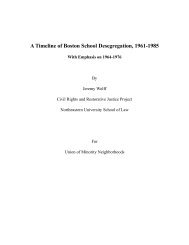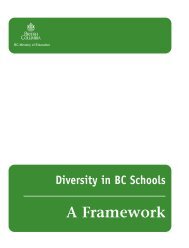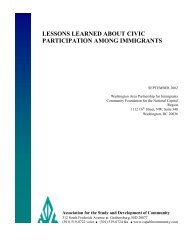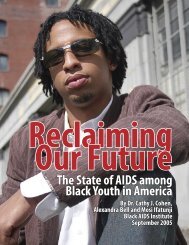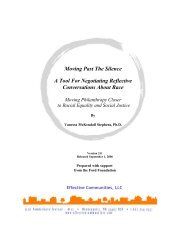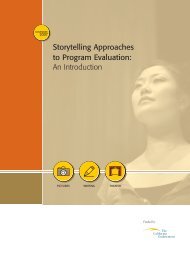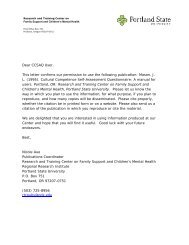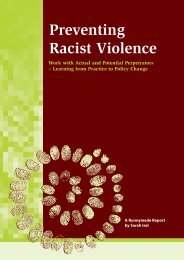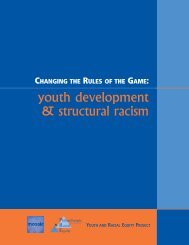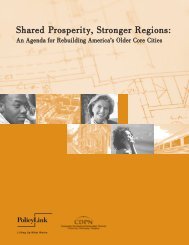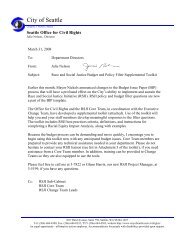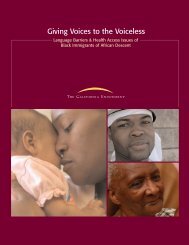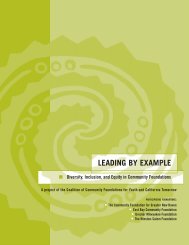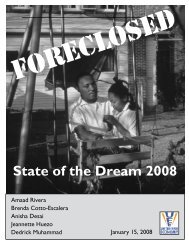REGIONAL OPPORTUNITYoldest regional advocacy groups. This provided anopportunity to support the build<strong>in</strong>g <strong>of</strong> a moreproactive regional agenda regard<strong>in</strong>g social <strong>and</strong>economic justice. In the RPA, Ford saw an experiencedgroup well-suited to conceive <strong>and</strong> implement a modelproject for advanc<strong>in</strong>g equitable developmentthroughout a metropolitan region, with a particularfocus on jobs, hous<strong>in</strong>g, <strong>and</strong> a just transportationnetwork. Through this model, the RPA could provideexperiences <strong>and</strong> lessons learned for replication by lessexperienced regional advocacy groups.Meanwhile <strong>in</strong> the Bay Area, the Local InitiativesSupport Corporation’s (LISC) <strong>in</strong>terest <strong>in</strong> The UnityCouncil predates the Ma<strong>in</strong> Street Program to the timewhen the organization was known as The SpanishSpeak<strong>in</strong>g UnityThe Unity Council has been anonpr<strong>of</strong>it communitydevelopment organizationcommitted to enrich<strong>in</strong>g thequality <strong>of</strong> life <strong>of</strong> familiesprimarily <strong>in</strong> the FruitvaleDistrict <strong>of</strong> Oakl<strong>and</strong>. Itsprimary focus has been tocreate a healthier <strong>and</strong> safercommunity for families <strong>and</strong>residents.Council, expla<strong>in</strong>sStephanie Forbes,Bay Area directorwith LISC. In theCouncil, LISC sawan organizationcommitted tohelp<strong>in</strong>g low-<strong>in</strong>comepeople, <strong>in</strong>itiallyfocus<strong>in</strong>g onFruitvale’s Lat<strong>in</strong>ocommunity, <strong>and</strong>later tak<strong>in</strong>g a moreholistic approach tothe <strong>in</strong>creas<strong>in</strong>glydiverse Fruitvale neighborhood. Much <strong>of</strong> The UnityCouncil’s appeal came from its underst<strong>and</strong><strong>in</strong>g <strong>of</strong> howphysical revitalization helps improve the quality <strong>of</strong> life(social, economic, environmental) for exist<strong>in</strong>gresidents. As a result, the Council pursued acomprehensive strategy that comb<strong>in</strong>ed services withneighborhood improvements.Accord<strong>in</strong>g to LISC’s Forbes, The Unity Council sawcommercial revitalization as a way to promote notsimply economic opportunity, but to foster astronger sense <strong>of</strong> community pride for communityresidents. Quality <strong>of</strong> life <strong>and</strong> how the Bay Area wasgrow<strong>in</strong>g were concerns for LISC. Big box stores were<strong>in</strong>creas<strong>in</strong>g <strong>in</strong> number, mak<strong>in</strong>g their economicpresence felt. Concerned about impacts on smaller,local merchants, LISC saw The Unity Council’sMa<strong>in</strong> Street Program as way to supportneighborhood economic vitality <strong>and</strong> support aneighborhood economy where bus<strong>in</strong>esses serv<strong>in</strong>glow-<strong>in</strong>come residents could survive <strong>and</strong> grow. TheMa<strong>in</strong> Street Program was a key way to ensure thatlocal bus<strong>in</strong>esses would benefit from the FruitvaleStation <strong>and</strong> the Fruitvale Transit Village. Forbes addsthat this early fund<strong>in</strong>g “would set the stage for agood relationship between the Bus<strong>in</strong>ess District, theBART Station, <strong>and</strong> the Transit Village.”F<strong>in</strong>ally, the Council was a known presence, anexperienced organization that already operatedmultiple <strong>and</strong> <strong>in</strong>tegrated programs to meet theFruitvale community varied needs. Informed by thesemultiple experiences, the Council well understoodthe Ma<strong>in</strong> Street pilot’s potential value to complementthe Council’s exist<strong>in</strong>g program <strong>and</strong> future plans.<strong>Regional</strong>/Neighborhood Equity ImpactsEast HarlemIn 2001, the RPA approached many differentcommunity-based organizations to identify an on theground partner for the East Harlem CommunityL<strong>in</strong>k Initiative. After discussions with communitydevelopment corporations (CDCs), healthorganizations, service organizations, tenantassociations, <strong>and</strong> many other groups, the RPA optedto work with a local government entity, CommunityBoard 11, because do<strong>in</strong>g so would give acommunity-based plann<strong>in</strong>g process clear access tothe city’s political structure (New York City is divided<strong>in</strong>to boroughs, which are further divided <strong>in</strong>tocommunity boards). The East Harlem CommunityL<strong>in</strong>k Initiative (the Initiative) became a partnershipbetween the Ford Foundation (the funder), RPA (thetechnical assistance provider), <strong>and</strong> CommunityBoard 11 (the client).On May 18, 2002, 50 Harlem community residentsled a team <strong>of</strong> urban design consultants <strong>and</strong> RPA staff<strong>in</strong> a vision<strong>in</strong>g session on the future <strong>of</strong> the communitywith a subway l<strong>in</strong>e along Second Avenue. The goals <strong>of</strong>the workshop were to envision East Harlem with theSecond Avenue Subway by identify<strong>in</strong>g potentialimprovements near proposed subway stations, creat<strong>in</strong>gvisual images, <strong>and</strong> present<strong>in</strong>g ideas to each other,public <strong>of</strong>ficials, <strong>and</strong> city agencies. The outcomes<strong>in</strong>cluded ideas, proposals, <strong>and</strong> maps <strong>and</strong> draw<strong>in</strong>gs thatrepresented concepts developed by the participants.Based on the workshop’s outcomes, the RPA began todevelop an implementation structure. It convened agroup that came to be called the East Harlem SecondAvenue Corridor Work<strong>in</strong>g Group (Work<strong>in</strong>g Group), a103Funders’ Network for Smart Growth <strong>and</strong> Livable Communities
multi-stakeholder effort composed <strong>of</strong> community<strong>in</strong>terests <strong>and</strong> government agencies. Accord<strong>in</strong>g to RPA’sassociate planner for community development,Nicolas Ronderos, the Work<strong>in</strong>g Group represented atransition from a strict TOD perspective (th<strong>in</strong>k<strong>in</strong>gabout <strong>and</strong> plann<strong>in</strong>g for the subway), to a greater focuson the Second Avenue Corridor with its physicaldesign <strong>and</strong> traffic flow, specifically as a means tomaximize economic opportunity while limit<strong>in</strong>ggentrification <strong>and</strong> displacement.A community design workshop hosted by the <strong>Regional</strong> Plan Association’sEast Harlem Community L<strong>in</strong>k Initiative on May 18, 2002. (Source: <strong>Regional</strong>Plan Association).The Initiative then focused on two research efforts: AL<strong>and</strong> Use Field Survey <strong>and</strong> a Zon<strong>in</strong>g Analysis. TheZon<strong>in</strong>g Analysis dealt with mid-2003 zon<strong>in</strong>g changes,where much <strong>of</strong> the East Harlem community wasrezoned for build<strong>in</strong>gs <strong>of</strong> greater height (12-stories, ascompared to the four-stories permitted by the earlierzon<strong>in</strong>g) to <strong>in</strong>crease density opportunities. In response,the analysis forecast the types <strong>of</strong> build<strong>in</strong>gs whichmight be possible under the new zon<strong>in</strong>g. Thevisualizations triggered concerns among Work<strong>in</strong>gGroup members <strong>of</strong> displacement, gentrification, <strong>and</strong>other negative changes on the exist<strong>in</strong>g community.They requested that RPA identify alternatives whichmight dim<strong>in</strong>ish the negative impacts <strong>of</strong> the zon<strong>in</strong>gchanges on exist<strong>in</strong>g residents <strong>and</strong> bus<strong>in</strong>esses. Thesealternatives would address affordable hous<strong>in</strong>g, urb<strong>and</strong>esign, <strong>and</strong> streetscape.Upon review <strong>of</strong> alternatives developed by RPA asrequested, the Work<strong>in</strong>g Group decided to prioritizenew streetscape opportunities, request<strong>in</strong>g aStreetscape Plan for Second Avenue. A strategy fordevelop<strong>in</strong>g <strong>and</strong> implement<strong>in</strong>g a Streetscape Plan,based on Work<strong>in</strong>g Group suggestions <strong>and</strong> the 2002Community Design Workshop, was approved <strong>in</strong>March 2004. Next, RPA conducted an <strong>in</strong>clusivesurvey <strong>of</strong> 100 Harlem bus<strong>in</strong>ess owners <strong>and</strong>employees (45 were Spanish-speakers <strong>and</strong> weresurveyed <strong>in</strong> Spanish) to help identify whichstreetscape elements would be most beneficial to theeconomic health <strong>of</strong> these bus<strong>in</strong>esses. The surveyedbus<strong>in</strong>esses <strong>and</strong> the Work<strong>in</strong>g Group viewed thestreetscape improvements specifically as a means toanticipate <strong>and</strong> avoid displacement, improve bus<strong>in</strong>essopportunities <strong>and</strong> bus<strong>in</strong>ess revenues, <strong>and</strong> spur localjob creation.As a result, Community Board 11 has proposed t<strong>of</strong>und some <strong>of</strong> the Streetscape Plan’s proposedimprovements <strong>in</strong> its Fiscal Year 2006 budget. Aproposal for longer-term <strong>in</strong>vestments has beendrafted <strong>and</strong> will be presented to city <strong>and</strong> stateagencies <strong>in</strong> 2005. The <strong>Regional</strong> Plan Associationplans to build on these successes to developcommunity consensus for higher-density hous<strong>in</strong>gthat <strong>in</strong>cludes a greatly exp<strong>and</strong>ed stock <strong>of</strong> affordablehous<strong>in</strong>g for community residents.Oakl<strong>and</strong>In Oakl<strong>and</strong>, The Unity Council has pursued twoapproaches to avoid displacement <strong>and</strong> ensure thatpopulations at risk have the opportunity <strong>and</strong> choiceto rema<strong>in</strong> <strong>in</strong> a gentrify<strong>in</strong>g neighborhood. The first issubsidy, us<strong>in</strong>g government <strong>and</strong> foundation dollars tomake up the gap between resident or small bus<strong>in</strong>ess<strong>in</strong>comes <strong>and</strong> grow<strong>in</strong>g market rate expenses (e.g.,affordable hous<strong>in</strong>g). The second is economicopportunity, where residents <strong>and</strong> bus<strong>in</strong>esses are giventhe means to see their <strong>in</strong>comes rise with the value <strong>of</strong>the area. This pr<strong>of</strong>ile focuses on the economicopportunity approach.Fruitvale Transit Village’s pedestrian plaza was anearly community priority. Community memberswanted a safe <strong>and</strong> easy connection from InternationalBoulevard to the BART station. First, with enhancedlocal access to the station, Fruitvale residents wouldhave better access to jobs outside <strong>of</strong> theirneighborhood result<strong>in</strong>g <strong>in</strong> a greater number <strong>and</strong>range <strong>of</strong> job opportunities <strong>and</strong> <strong>in</strong>creased personal<strong>in</strong>comes. Local bus<strong>in</strong>esses would also benefit fromthe connection, as commuters could be drawn totheir shops <strong>and</strong> <strong>in</strong>crease their revenue potential.Furthermore, local bus<strong>in</strong>esses can now access public<strong>and</strong> private dollars to improve the appearance <strong>of</strong>their build<strong>in</strong>gs through the Fruitvale Ma<strong>in</strong> StreetProgram. The program is a comprehensivecommercial district revitalization project focused onInternational Boulevard <strong>and</strong> the area surround<strong>in</strong>g theFruitvale Village.REGIONAL OPPORTUNITYPart III: Section 3: Connect<strong>in</strong>g to <strong>Regional</strong> Opportunity 104
- Page 1 and 2:
Stories of Philanthropic Leadership
- Page 3 and 4:
Signs of Promise:Stories of Philant
- Page 5 and 6:
Funders’ Network for Smart Growth
- Page 7 and 8:
(II. B.)(II. C.)Turning Neighborhoo
- Page 9 and 10:
PART I:IntroductionThe Purpose of t
- Page 11 and 12:
social justice issues as they relat
- Page 13 and 14:
PART II:Perspectives on Advancing R
- Page 15 and 16:
peer work, we can reestablish a sig
- Page 17 and 18:
Annie E. Casey FoundationBaltimore,
- Page 19 and 20:
neighborhoods into healthy ones—g
- Page 21 and 22:
Charles and Helen Schwab Foundation
- Page 23 and 24:
Section 1:Promoting Equitable Publi
- Page 25 and 26:
I. A. BUILDING POWER AND GIVINGVOIC
- Page 27 and 28:
policy advocates. In 2002, Milwauke
- Page 29 and 30:
in Los Angeles, Ford’s Anthony no
- Page 31 and 32:
I. B. PROMOTING COALITIONSTO ADVANC
- Page 33 and 34:
Yet the interpersonal dynamics of c
- Page 35 and 36:
guidelines. “Many of the member o
- Page 37 and 38:
Funder InterestThe EPA supported th
- Page 39 and 40:
I. D. DEMONSTRATING THESTRUGGLE FOR
- Page 41 and 42:
Richmond, Calif.The second regional
- Page 43 and 44:
through policy reform at the local
- Page 45 and 46:
I. E. BUILDING COALITIONTHROUGH KNO
- Page 47 and 48:
organizing project, the Connecticut
- Page 49 and 50:
and businesses are quantified in a
- Page 51 and 52:
I. G. REVITALIZING WHILEASSURING DI
- Page 53 and 54:
In the late 1990s, the city of Albu
- Page 55 and 56:
I. H. A TRAVEZ DE LA FRONTERA:LAND
- Page 57 and 58:
The International Community Foundat
- Page 59 and 60: I. I. MOBILIZING ACTION FORREGIONAL
- Page 61 and 62: To meet all of these objectives, th
- Page 63 and 64: efforts. And with each public plann
- Page 65 and 66: pattern of disproportionate transpo
- Page 67 and 68: Clinica de la Raza identify this cr
- Page 69 and 70: Contact PeopleCarl AnthonyActing Di
- Page 71 and 72: Section 2:Making All Neighborhoods
- Page 73 and 74: II. A. REACHING BEYONDHOUSING TO IM
- Page 75 and 76: A local resident receives the keys
- Page 77 and 78: East Baltimore community and the Jo
- Page 79 and 80: example, adjacent to the EBDI area,
- Page 81 and 82: II. C. YIELDING REGIONALBENEFITS TH
- Page 83 and 84: is using transit-oriented developme
- Page 85 and 86: financing and innovative, forward-t
- Page 87 and 88: The Row House Community Development
- Page 89 and 90: II. E. COUNTERING THE PERFECTSTORM:
- Page 91 and 92: funded community programs, includin
- Page 93 and 94: housing developments and commercial
- Page 95 and 96: owned enterprises, totaling $8.5 mi
- Page 97 and 98: LOAN GUARANTEESSection 3:Connecting
- Page 99 and 100: III. A. MAKING HOUSING ANOPPORTUNIT
- Page 101 and 102: A new report from the National Hous
- Page 103 and 104: The Straphangers Campaign was found
- Page 105 and 106: Funder InterestThe Straphangers Cam
- Page 107 and 108: or increase poverty. Whether direct
- Page 109: The Regional Plan Association then
- Page 113 and 114: director with LISC. No one set of s
- Page 115 and 116: 12 western Louisville neighborhoods
- Page 117 and 118: III. E. UNITING THREE STATESFOR ONE
- Page 119 and 120: increased their personal wealth by
- Page 121 and 122: summary evaluation of MSDI found th
- Page 123 and 124: method alone was strong enough to m
- Page 125 and 126: consistent body of work. The Counci
- Page 127 and 128: 3) Issues Need to be ConnectedThe f
- Page 129 and 130: PART V:Glossary of TermsThe terms d
- Page 131 and 132: Regional and neighborhood equity. A
- Page 133 and 134: Tijuana River Reserve, California:h
- Page 135 and 136: Sargent Shriver National Center on
- Page 137: 1500 San Remo Avenue • Suite 249



